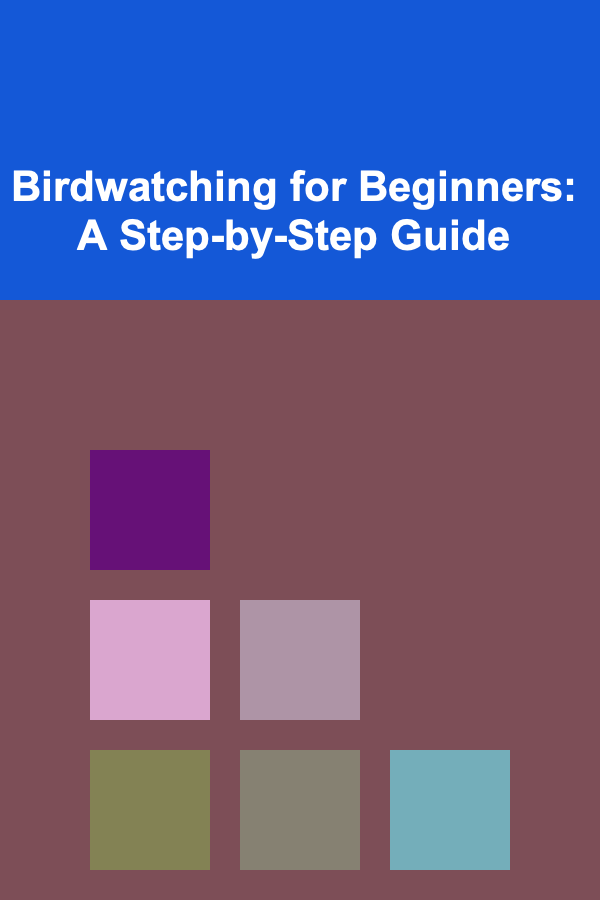
Birdwatching for Beginners: A Step-by-Step Guide
ebook include PDF & Audio bundle (Micro Guide)
$12.99$8.99
Limited Time Offer! Order within the next:

Birdwatching, also known as birding, is a popular and rewarding outdoor activity that allows you to connect with nature, learn about different bird species, and enjoy the beauty of wildlife. Whether you're a nature enthusiast, a photography hobbyist, or someone simply looking for a peaceful outdoor activity, birdwatching offers a range of experiences for all skill levels. For beginners, it may seem intimidating at first, but with the right knowledge and tools, anyone can become an expert birder. This guide will take you through the essential steps to get started in birdwatching, from understanding the basics to identifying birds and getting the most out of your birding experience.
Why Birdwatching?
Before diving into the specifics of birdwatching, it's essential to understand why this activity has gained so much popularity. Birdwatching offers numerous benefits, both physical and mental:
- Connection with Nature: Birdwatching allows you to experience the outdoors in a meaningful way. Spending time in nature can help reduce stress and promote overall well-being.
- Educational Value: Birding teaches you about biodiversity, ecosystems, and the important role birds play in maintaining a balanced environment.
- Physical Activity: Walking, hiking, or even cycling while birdwatching can improve cardiovascular health and offer an enjoyable form of exercise.
- Mental Relaxation: Birdwatching encourages mindfulness, helping you slow down and appreciate the moment. It requires focus and patience, making it a meditative experience for many.
- Community: Birdwatching has a thriving community of enthusiasts, and you may find yourself joining local birding groups or participating in birding events.
Birdwatching can be as simple as sitting in your backyard or as adventurous as trekking through forests or wetlands. No matter the location, you'll find that birding can be a rewarding and fascinating pursuit.
Basic Birdwatching Equipment
To get started, you don't need much gear, but having the right tools can enhance your experience. Here's a list of the essential equipment you'll need as a beginner:
a. Binoculars
The most important tool for birdwatching is a good pair of binoculars. They allow you to get a closer look at birds from a distance without disturbing them. When choosing binoculars, look for:
- Magnification: Binoculars with 8x or 10x magnification are great for birdwatching. Higher magnification can make it harder to focus on moving birds.
- Field of View: A wider field of view is beneficial for tracking fast-moving birds.
- Weight: Choose lightweight binoculars for comfort, especially if you plan to carry them for long periods.
b. Field Guide
A bird field guide is a must-have for identifying birds. Field guides contain pictures, descriptions, and information about various bird species. You can buy a printed guide specific to your region or use a digital version or app on your phone. Popular apps like Merlin Bird ID or iBird can help you identify birds by asking simple questions about their size, color, and location.
c. Notepad and Pen
Many birdwatchers keep a field journal to record their observations. This is a great way to track the species you've seen, the locations where you've spotted them, and any interesting behaviors or features you noticed.
d. Appropriate Clothing and Footwear
Since birdwatching often involves walking through nature reserves, forests, or other outdoor environments, comfortable and weather-appropriate clothing is essential. Layered clothing is recommended for changing temperatures. Additionally, wearing sturdy, waterproof boots will keep you comfortable while trekking through muddy or uneven terrain.
e. A Camera (Optional)
If you're interested in photography, bringing a camera or smartphone with a good zoom lens can be a rewarding way to document your bird sightings. However, remember that the main goal of birdwatching is to enjoy the experience, not just capture pictures.
Birdwatching Etiquette
Birdwatching is all about respect for the birds and their natural habitat. Keeping a few simple rules in mind will ensure that you have a positive experience while minimizing your impact on wildlife:
- Be Quiet: Birds are easily startled by loud noises. Speak in hushed tones and avoid sudden movements that may alarm them.
- Respect Wildlife: Never approach or disturb birds. Stay at a reasonable distance, and never attempt to feed wild birds, as it can disrupt their natural feeding patterns.
- Leave No Trace: If you're hiking or exploring nature reserves, be mindful of the environment. Stick to trails, pack out your trash, and avoid damaging plants or trees.
- Be Patient: Birds can be elusive, and it may take time to spot them. Patience is key in birdwatching, so enjoy the process of observing the birds and their surroundings.
Where to Birdwatch
Birdwatching can be done almost anywhere, but some locations are better for spotting a wider variety of species. Here are a few of the best places to start:
a. Backyard Birdwatching
You don't need to travel far to start birdwatching. Your own backyard can be a great place to spot common birds, especially if you have bird feeders or trees that attract them. By observing the species that visit your yard, you can learn about their habits, flight patterns, and songs.
b. Local Parks and Nature Reserves
Most cities and towns have local parks or nature reserves where you can spot various bird species. Parks often have trails, wetlands, and woodlands that attract a variety of birds. Look for areas with water, as birds are often attracted to lakes, rivers, or marshes.
c. Wetlands and Marshes
Wetlands, swamps, and marshes are excellent habitats for waterfowl and migratory birds. These areas are rich in biodiversity, and you may see species such as herons, egrets, ducks, and shorebirds. Bring binoculars with you, as birds in wetlands can be further away and require a closer look.
d. Forests and Woodlands
Forests provide habitats for many songbirds, woodpeckers, owls, and raptors. Visit forests during different seasons to observe how the bird populations change with migration patterns. Early morning or late afternoon is typically the best time for birdwatching, as birds are more active during these times.
e. Coastal Areas
If you live near the coast, beaches and coastal habitats are fantastic for spotting seabirds, shorebirds, and migrating birds. You may see species like seagulls, sandpipers, terns, and even pelicans if you're near the ocean.
Bird Identification Basics
As you begin birdwatching, one of the most exciting challenges is learning to identify birds. Here are some key features to focus on when trying to identify a bird:
a. Size and Shape
Observe the overall size and shape of the bird. Is it small like a sparrow or large like an eagle? The shape of the bird can tell you a lot about its species, such as whether it has a long neck, short wings, or a large, curved beak.
b. Color Patterns
Look for distinctive color patterns. Pay attention to the bird's plumage, including its main body color, wings, tail, and any markings like spots, stripes, or a crest. Colors can change with the seasons, so be aware of variations in plumage.
c. Behavior and Habitat
Observe the bird's behavior. Is it perched high in a tree or foraging on the ground? Birds behave differently depending on their species and the environment. For example, hawks might be seen soaring high, while robins are often seen hopping on the ground.
d. Song and Call
Birdsong is one of the most distinctive ways to identify a bird. Many species have unique calls, and learning their songs can help you identify birds even when you can't see them. Apps and online resources often include audio clips of bird songs.
e. Location
The location where you spot the bird is an important clue. Certain species prefer specific habitats, such as wetlands, forests, or urban areas. Field guides and apps typically include maps showing the best places to spot certain birds based on their habitat preferences.
Building Your Birdwatching Skills
Birdwatching is a skill that improves with practice. As a beginner, you'll want to build your skills over time. Here are a few tips for improving your birdwatching:
- Join a Birdwatching Group: Birdwatching groups are a great way to learn from experienced birders. You can participate in guided birding walks and attend events where you can meet fellow enthusiasts.
- Take Notes: Keep a birdwatching journal where you write down the birds you've seen, their behaviors, and the locations. This will help you track your progress and build your knowledge over time.
- Use Birding Apps: Apps like Merlin Bird ID or eBird can help you identify birds and log your sightings. eBird is also a great resource for learning about bird migration patterns and tracking sightings in your area.
- Observe Patterns: Birds follow migration routes and exhibit seasonal behaviors. By paying attention to patterns, you'll become more familiar with which birds are in your area during different times of the year.
Birdwatching Etiquette and Conservation
While birdwatching is an enjoyable and fulfilling activity, it's important to remember the ethical responsibility we have as stewards of nature. Always practice respectful birdwatching by not disturbing the birds and following ethical guidelines for outdoor activities.
Conservation is an essential aspect of birdwatching. Many bird species are threatened by habitat loss, climate change, and pollution. Supporting bird conservation efforts and becoming involved in environmental causes can help protect the natural habitats of the birds you love to watch.
Birdwatching is a lifelong learning experience that brings joy, knowledge, and a deeper connection with the natural world. As a beginner, don't worry about identifying every bird perfectly---just focus on enjoying the process of observation, and with time, you'll develop the skills needed to become an expert birder. So grab your binoculars, head outside, and start exploring the fascinating world of birds!
Reading More From Our Other Websites
- [Metal Stamping Tip 101] Emerging Trends: Automation and Smart Technologies in Aluminum Metal Stamping
- [Home Storage Solution 101] How to Organize Sports Equipment with Clever Storage Ideas
- [Personal Care Tips 101] How to Maintain a Razor Blade for Long-Lasting Performance
- [Simple Life Tip 101] How to Reduce Digital Clutter: A Step‑by‑Step Guide to Inbox Zero
- [Home Lighting 101] How to Light Your Kitchen for Maximum Functionality
- [Organization Tip 101] How to Organize Volunteer Opportunities for Charity Work
- [Home Soundproofing 101] How to Soundproof with Spray Foam for Maximum Noise Reduction
- [Home Holiday Decoration 101] How to Set Up a Festive Holiday Photo Booth for Memorable Family Photos
- [Home Security 101] How to Use a Home Security Checklist to Ensure Maximum Safety
- [Soap Making Tip 101] Best Tips for Preventing Soap‑Sickness in DIY Soap Workshops

How to Incorporate Lighting into Your Home Renovation
Read More
How to Organize Recipes with Visual Inspiration Boards
Read More
How to Understand Risk and Reward in Personal Investments
Read More
How to Use Slow Cookers and Instant Pots for Meal Prep
Read More
How To Deliver an Engaging Storytelling Session
Read More
How To Choose the Right Outerwear for Every Season
Read MoreOther Products

How to Incorporate Lighting into Your Home Renovation
Read More
How to Organize Recipes with Visual Inspiration Boards
Read More
How to Understand Risk and Reward in Personal Investments
Read More
How to Use Slow Cookers and Instant Pots for Meal Prep
Read More
How To Deliver an Engaging Storytelling Session
Read More